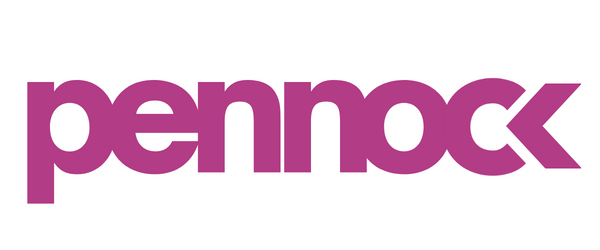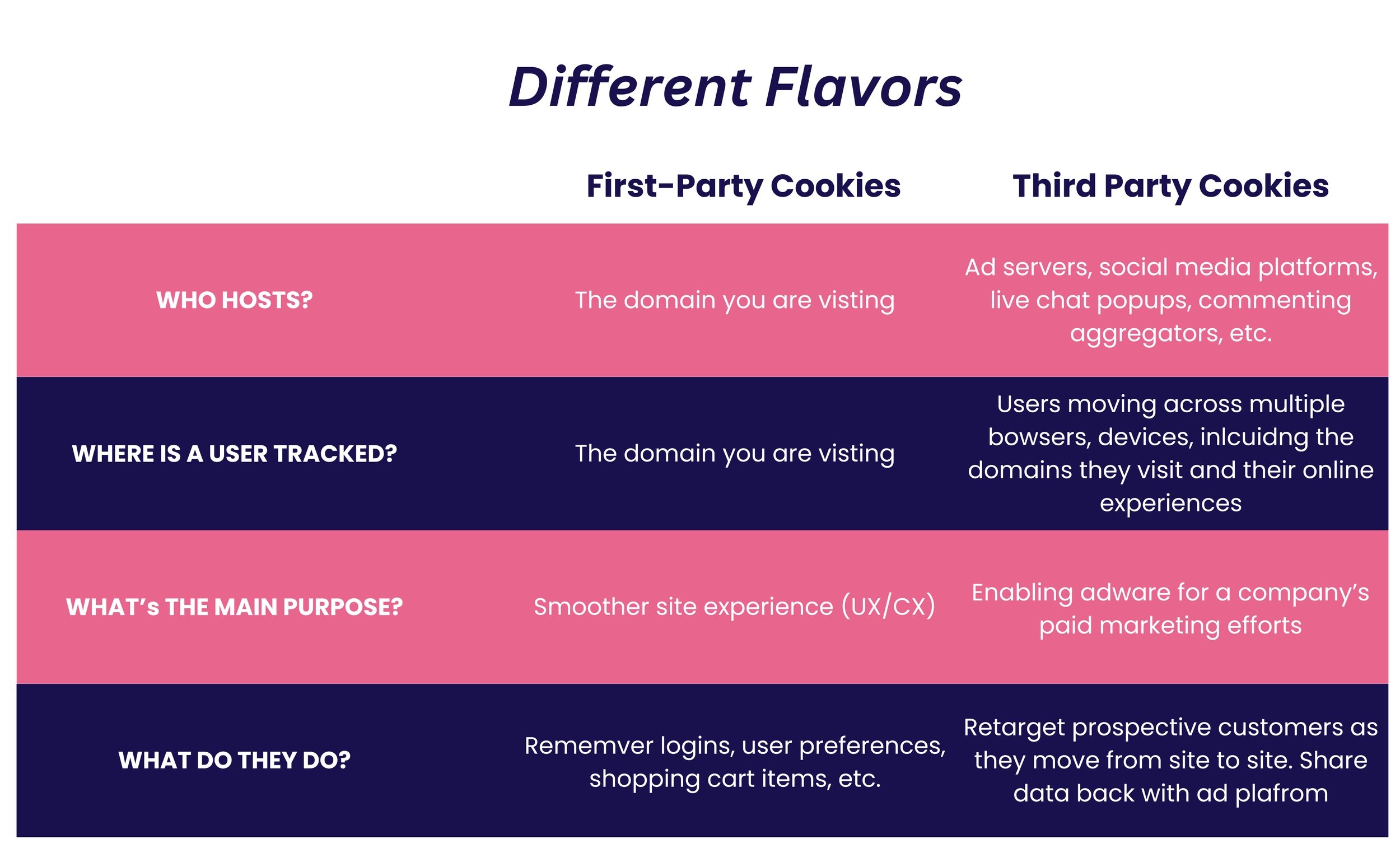Post-Third Party Cookie Era
Adapting Strategies for Targeted Marketing
Data privacy isn’t a new concern—Apple’s Safari and Mozilla’s Firefox browsers have been blocking cookies for almost a decade.
But the news that Google planned to follow suit rocked the industry. That’s because Google Chrome is by far the most popular browser, accounting for over 63% of global web traffic.
What are Cookies?
Cookies are a bit of JavaScript embedded in a website that stores data about a particular browsing session. Cookies come in four main flavors.
We’ll talk mostly about 1st party and 3rd.
to collect user data for the third party. As with standard cookies, third-party cookies are placed so that a site can remember something about the user. Third-party cookies, however, are often set by advertising networks that a website might subscribe to in the hopeof driving up sales or page views. For example, if a user visits a website named news.com, a cookie placed on this domain by news.com is a first-party cookie. A cookie placed by any other site, such as an advertiser or social media site, is a third-party cookie.
In contrast to first-party cookies, which can only gather user data when users interact with the owner's website, third-party cookies track users across several websites, providing a more comprehensive picture of user behavior.
First-party cookies are usually generated and placed on the user’s device by the website that the user is visiting. Such cookies are often used for facilitating user experience and some core functionalities of the site. For example, first-party cookies can identify returning visitors so that they do not have to use the username and password to log in on successive visits. They are usually harmless since they do not “spy” on the users.
Third-party cookies are most frequently used for online advertising. These cookies track a user's browsing history and activities so they can present them with personalized ads for products and services.
A third-party cookie is placed on a website by someone other than the owner -- a third party
Data Deprecation Can Impact Many Teams
Impact on Paid Media:
All advertising channels that rely on third-party cookies will be impacted. As such, the move away from third-party cookies will require a shift towards alternative identifiers for tracking and measurement, such as first-party cookies, mobile ad IDs, and browser fingerprinting.
Attribution Challenges: Shorter lifespans of cookies make it difficult to accurately track customer journeys over a longer period. This impacts attribution models, particularly those reliant on long-term user behavior..
MTA Limitations: Multi-touch attribution models will face challenges in accurately distributing credit for sales or conversions across different touchpoints, particularly in top-of-funnel activities.
Click-based Tracking Remains Viable: Ads that are clicked and lead to consent-given interactions on a website will still be trackable in tools like GA4. This means conversion attribution for such ads is less affected.
Targeting and Retargeting Changes: Advertisers will need to rethink targeting strategies, especially for retargeting campaigns that traditionally depend on third-party cookie data to track users across the web.
When Google is planning to deprecate 100% of Chrome third party cookies:
On 1/4/2024 Google deprecated third-party cookies for 1% of randomly selected Chrome users worldwide to test alternative solutions. Pending approval from the UK Competition and Markets Authority, Google says their plan is to deprecate 100% of Chrome third-party cookies in Q1 of 2025 (pushed back from Q3 2024)
Advertisers new multifaceted approach
Innovate with contextual advertising: advertisers can granularly target audiences by serving ads that are relevant to the content on a website. This can be done at the category level (i.e., the Fashion section of The New York Times) and keyword level. In the absence of third-party data targeting, context becomes an important proxy for the audience. After all, people who are interested in beauty products are highly likely to read articles about beauty brands. Contextual targeting solutions can develop inventory packages for tailored contexts, allowing advertisers to improve performance and reach the right audience.
We can do contextual targeting for platforms like Google ads and programmatic ads.
Key strategies to optimize contextual advertising include:
• Embracing AI And ML: Utilize these technologies to analyze content and match ads contextually.
• Implementing Dynamic Matching: Adjust ads in real time to align with user-engaged content.
• Ensuring Data Quality: Use comprehensive and nuanced data for AI model accuracy.
• Adapting And Refining: Regularly review and tweak AI-driven placements for relevancy.
As the digital landscape evolves, our approach is to innovate and thrive in this new zero-party and first-party environment. Here are some alternatives for third party cookies:
Lean on first-party data: while external sources like Google Chrome can’t track 1st party user data, media buyers will continue to get valuable insight into website user behavior.
We can continue to use 1st party data to create audiences and segment users based on their website behavior and interactions. Segmentation allows us to show different ads to different types of users. For example, we can retarget those who left without making a purchase, or target users who have previously made purchases or shown interest in related products with personalized offers to encourage repeat purchases.
Key strategies for enhancing user engagement with first-party data:
• Creating Interactive Content: Engage users with quizzes, polls and webinars to transform them from passive viewers to active participants.
• Designing Engaging Loyalty Programs: Offer exclusivity and value beyond rewards to foster a sense of belonging.
• Simplifying Website Navigation: Balance innovative design with user-friendly interfaces to encourage exploration.
Bigger Investments in “Walled Gardens”: The biggest winners are likely to be those with the biggest “walled gardens”, those with huge media properties that users are incentivized to stay within for a long period of time, and which own a great deal of user data. This includes Google, Facebook, and Amazon.
There’s an even greater incentive for web owners to find ways to keep visitors within their own portfolio of domains. Google is a good example of this – by cutting off third-party cookies the brand is consolidating its own dominance online.
Enable First-Party Cookies with the Meta Pixel: Within the Events Manager, go to Data Sources and then the Settings tab. There is a section for Cookie Usage. Make sure first party cookies are on.
Connect the Conversions API: Facebook has developed the Conversions API (CAPI) to share data directly from their server, rather than through a browser to bypass any loss of cookie support. These are set up on your server and allow you to send ‘events’, such as clicks on a contact form, directly from your server to third-party advertising platforms. As the data is on your server, you own it all – unlike a web pixel, which is client-side. This also means your conversion API is not limited by third-party cookies or browser settings.
Here is the meta setup guide for developers.
TikToK Ads Third Party Cookie Solution: When it comes to third-party cookie-less solutions for TikTok ads, one alternative is to use a custom tracking solution provided by ad tracking software. This approach requires a more complex setup initially, but it is considered more trustworthy and reliable for tracking TikTok ads.
It's important to note that TikTok itself has options for using first- and third-party cookies with their TikTok Pixel, allowing for cookie usage while also providing advanced matching capabilities. However, the industry is moving towards a post-cookie world, and finding third-party cookie-less solutions should be considered for future-proofing your advertising strategies.
Alternative Marketing Strategies
Google’s new privacy-focused technologies are one alternative you can use, but they are likely to remain in development for most of 2023.
Some companies have begun developing their own tracking tools to replace cookies. However, the legality of these new tools may change as privacy concerns continue to grow.
Others are returning to tried-and-true strategies like content marketing and contextual advertising. Some examples of alternatives to cookies include:
Alternate IDs: Third-party alternate IDs like Unified ID 2.0 (UID 2.0) enable you to efficiently target specific audiences without infringing on anyone’s privacy. Essentially, they function like third-party cookies without the security concerns.
Predictive Audiences: A new feature of Google Analytics 4, Predictive Audiences allows you to leverage predictive metrics via AI to understand buyer behavior. For example, you can use Predictive Audiences to target those most likely to purchase a specific product without relying on IDs.
Seller-defined audiences (SDAs): SDAs allow publishers to create and sell targetable audiences without IDs. Although they’re still fairly new to the scene, Google’s timeline update may give publishers enough time to perfect them.
Search engine optimization (SEO): The overall ROI of organic SEO is much higher than that of paid advertising. Understanding user intent and identifying popular search terms can help you develop a much deeper understanding of your target audience so you can deliver more personalized ads.
Content marketing: Publishing relevant content throughout the conversion funnel can help you attract and win over the right audience. You can also use your premium content to collect leads. For example, you could offer access to a free webinar or white paper in exchange for an email address or a phone number.
Subscriptions/Email marketing: Twenty-three percent of marketers plan to invest more in email marketing software to get around Google’s new policy.
Zero-party data: Information that users voluntarily give to a brand, such as purchase intent, preference center data and personal context.
Experimenting with these or other alternatives can help you become more digitally resilient, which is key to thriving in the ever-evolving digital marketplace. Building trust with your audience by being transparent about the information you collect should be a priority moving forward.
In Summary
with the end of third-party cookies comes the opportunity for new technology to emerge. Your business will be able to explore new advertising strategies and techniques, rather than relying solely on the data gathered from third-party cookies. It is vital that you test out different options and discover what works for your company before third-party cookies are removed so you can be prepared for the change.



